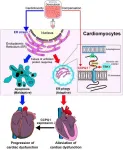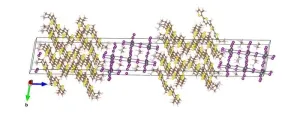(Press-News.org) Ion channels are attractive drug targets due to their importance in health and disease, but finding ways to target a specific ion channel selectively is a major challenge. Now, researchers at Weill Cornell Medicine and RMIT University in Australia have discovered that ion channels called BK channels have unique openings in their sides, which drug molecules may be able to access. The finding, published Aug. 31 in Nature Chemical Biology, could lead to the development of selective drugs that target the BK channel to treat a wide range of diseases.
Ion channels are tunnel-like structures embedded in cell membranes that control the flow of charged molecules in or out of cells, which is required for many biological processes. BK channels, for instance, conduct the flow of potassium ions and inherited mutations in these channels have been linked to problems in multiple organ systems.
“The discovery of a site where small molecules can selectively access this important type of ion channel is an exciting development,” said study co-senior author Dr. Crina Nimigean, professor of physiology and biophysics in anesthesiology at Weill Cornell Medicine.
The other co-senior author of the study is Dr. Toby Allen, a professor at RMIT University in Melbourne, Australia. The first author, Dr. Chen Fan, was a postdoctoral research associate in the Nimigean Lab in the Department of Anesthesiology during the study.
Dr. Nimigean and her team have been exploring the structure and function of BK channels, both directly and with experiments on a bacterial version called MthK that is easier to study in the laboratory. Recently, they observed that a family of MthK- and BK-blocking compounds—not suitable as drugs but useful as laboratory tools—can access and effectively plug the MthK channel, or “pore,” even when structural imaging shows that the entrance to the pore is fully closed.
“Since these compounds wouldn’t have direct access to the pore in this closed state, we wondered how they were able to get in,” Dr. Nimigean said.
To resolve this conundrum, the researchers turned to structural imaging methods, experiments with normal and mutated MthK, and, in Dr. Allen’s laboratory, computer modeling of the interactions between the channel-blocking compounds and the MthK ion channel.
They discovered that when MthK is in the closed state, the structure develops large openings on its sides through which the MthK-blocking compounds can access the ion-conducting pore. These openings are inside the cell membrane, so the MthK-blocking compounds must first travel a short distance into the membrane to reach them.
The researchers also observed from existing structural data that side-openings or “fenestrations” like those in the MthK channels are present in BK channels as well.
Scientists believe that BK-blocking or -activating drugs could help treat disorders such as epilepsy and hypertension. However, no selective BK channel-modulating drug exists, in part because little is known about how changes in the BK channel structure relate to the channel’s function. Another problem is drugs that affect BK channels also interact with other ion channels because they typically target the entrance to the potassium-conducting chute or “pore,” which is not very different from the pores of other types of ion channels. Such indiscriminate interactions could lead to havoc in the body.
“These fenestrations are unique to BK-type channels, which suggests that future drugs targeting these sites could work as selective BK channel blockers or activators,” Dr. Nimigean said.
She and her team are planning follow up experiments in BK channels and hope to use their findings to discover selective BK channel-modulating compounds that could be developed into drugs.
END
Discovery opens possibility of new ion channel-targeting drugs
2023-08-31
ELSE PRESS RELEASES FROM THIS DATE:
Analog and digital: The best of both worlds in one energy-efficient system
2023-08-31
We live in an analog world of continuous information flow that is both processed and stored by our brains at the same time, but our devices process information digitally in the form of discrete binary code, breaking the information into little bits (or bites). Researchers at EPFL have revealed a pioneering technology that combines the potential of continuous analog processing with the precision of digital devices. By seamlessly integratingultra-thin, two-dimensional semiconductors with ferroelectric materials, the research, published in Nature Electronics, unveils a novel way to improve energy efficiency and add new functionalities in computing. The ...
Coastal fisheries show surprising resilience to marine heat waves
2023-08-31
Rutgers-led research found that marine heat waves – prolonged periods of unusually warm ocean temperatures – haven’t had a lasting effect on the fish communities that feed most of the world.
The finding is in stark contrast to the devastating effects seen on other marine ecosystems cataloged by scientists after similar periods of warming, including widespread coral bleaching and harmful algal blooms.
“There is an emerging sense that the oceans do have some resilience, and while they are changing in response ...
A new breakthrough in obesity research allows you to lose fat while eating all you want
2023-08-31
This is a significant development that brings hope to the one billion individuals with obesity worldwide. Researchers led by Director C. Justin LEE from the Center for Cognition and Sociality (CCS) within the Institute for Basic Science (IBS) have discovered new insights into the regulation of fat metabolism. The focus of their study lies within the star-shaped non-neuronal cells in the brain, known as 'astrocytes'. Furthermore, the group announced successful animal experiments using the newly developed drug 'KDS2010', which allowed the mice to successfully achieve weight loss without resorting ...
New blood test for noncoding RNA significantly improves cancer detection
2023-08-31
Cancer is most treatable in its early stages, so finding innovative and non-invasive methods to diagnose cancer early on is crucial for fighting the disease. Liquid biopsies, which require just a simple blood draw, are an emerging technology for non-invasively testing for cancer using DNA or RNA sequencing of a patient’s blood.
Assistant Professor of Biomolecular Engineering Daniel Kim and his lab are developing more accurate and powerful liquid biopsy technologies that take advantage of signals from RNA “dark matter,” an understudied ...
Largest genetic study of epilepsy to date provides new insights on why epilepsy develops and potential treatments
2023-08-31
Thursday, 31 August 2023: The largest genetic study of its kind, coordinated by the International League Against Epilepsy, including scientists from FutureNeuro at RCSI University of Medicine and Health Sciences, has discovered specific changes in our DNA that increase the risk of developing epilepsy.
The research, published today in Nature Genetics, greatly advances our knowledge of why epilepsy develops and may inform the development of new treatments for the condition.
Epilepsy, a common brain disorder of which there are many different types, is known to have genetic component and to sometimes run in families. Here, researchers compared the DNA from diverse groups of almost ...
Intracellular recycling: the key to surviving potent anti-cancer drugs
2023-08-31
Researchers from Tokyo Medical and Dental University(TMDU) determine how cardiomyocytes protect themselves against anti-cancer medication
Tokyo, Japan – A cell contains many specialized subunits, called organelles, that carry out important tasks such as energy generation, protein synthesis, and calcium outflux. But what happens when something goes wrong with one of the organelles?
In a study recently published in the Journal of the American College of Cardiology: CardioOncology, researchers from Tokyo Medical and Dental University(TMDU) have ...
Growing triple-decker hybrid crystals for lasers
2023-08-31
By controlling the arrangement of multiple inorganic and organic layers within crystals using a novel technique, researchers at Duke University and Purdue University have shown they can control the energy levels of electrons and holes (positive charge carriers) within a class of materials called perovskites. This tuning influences the materials’ optoelectronic properties and their ability to emit light of specific energies, demonstrated by their ability to function as a source of lasers.
Appearing online August 31 in the journal Nature Chemistry, the research is the result of a close collaboration between several ...
Positive framing of genomics met with scepticism in some communities
2023-08-31
August 31, 2023 - New research published today in Human Genetics and Genomics Advances reveals the difference between ‘what we say’ and ‘what people hear’ when engaging underrepresented communities around genomics and healthcare.
Genomics datasets, which underpin the ability to interpret all genetic tests, are known to consist of DNA from predominately white, Northern European populations. As genomics becomes an increasingly important part of everyday healthcare*, barriers to diverse participation must be overcome so that everyone can benefit from genomic medicine, not just the privileged few.
The research ...
People who are in good shape take fewer mental-health related medication
2023-08-31
“We find that people who are in better shape fill fewer prescriptions for anxiety and depression medications,” says Linda Ernstsen, the senior author of the article and an associate professor from the Department of Public Health and Nursing at the Norwegian University of Science and Technology (NTNU).
The research group based its work on the Trøndelag Health Study (HUNT). Since 1984, 250,000 Trøndelag residents have voluntarily contributed their health data to this comprehensive ...
Breathe! The shape-shifting ball that supports mental health
2023-08-31
A soft ball that ‘personifies’ breath, expanding and contracting in synchronicity with a person’s inhalations and exhalations, has been invented by a PhD student at the University of Bath in the UK. The ball is designed to support mental health, giving users a tangible representation of their breath to keep them focused and to help them regulate their emotions.
Alexz Farrall, the student in the Department of Computer Science who invented the device, said: "By giving breath physical form, the ball enhances self-awareness and engagement, fostering positive mental health outcomes."
Generally, ...





